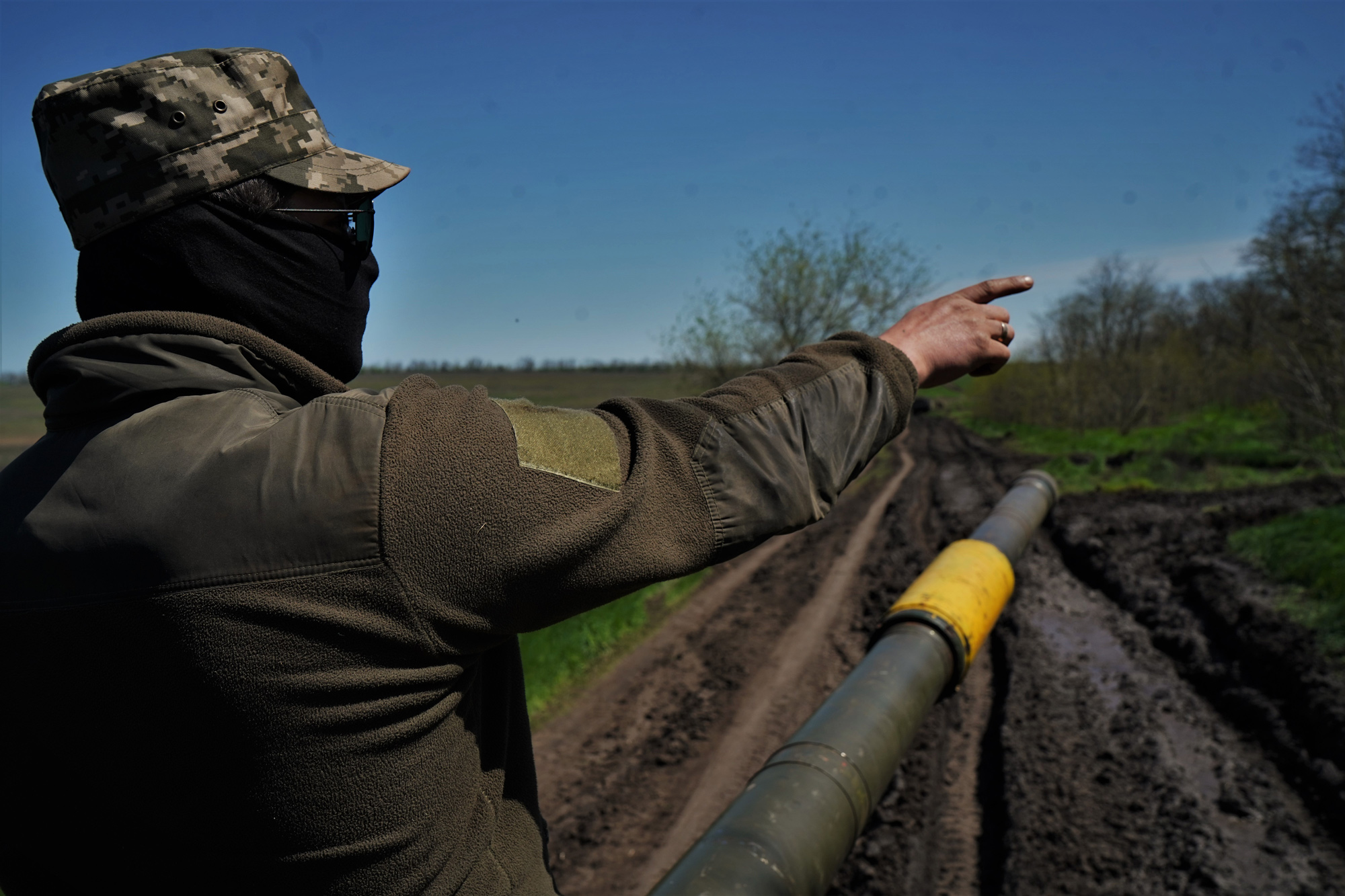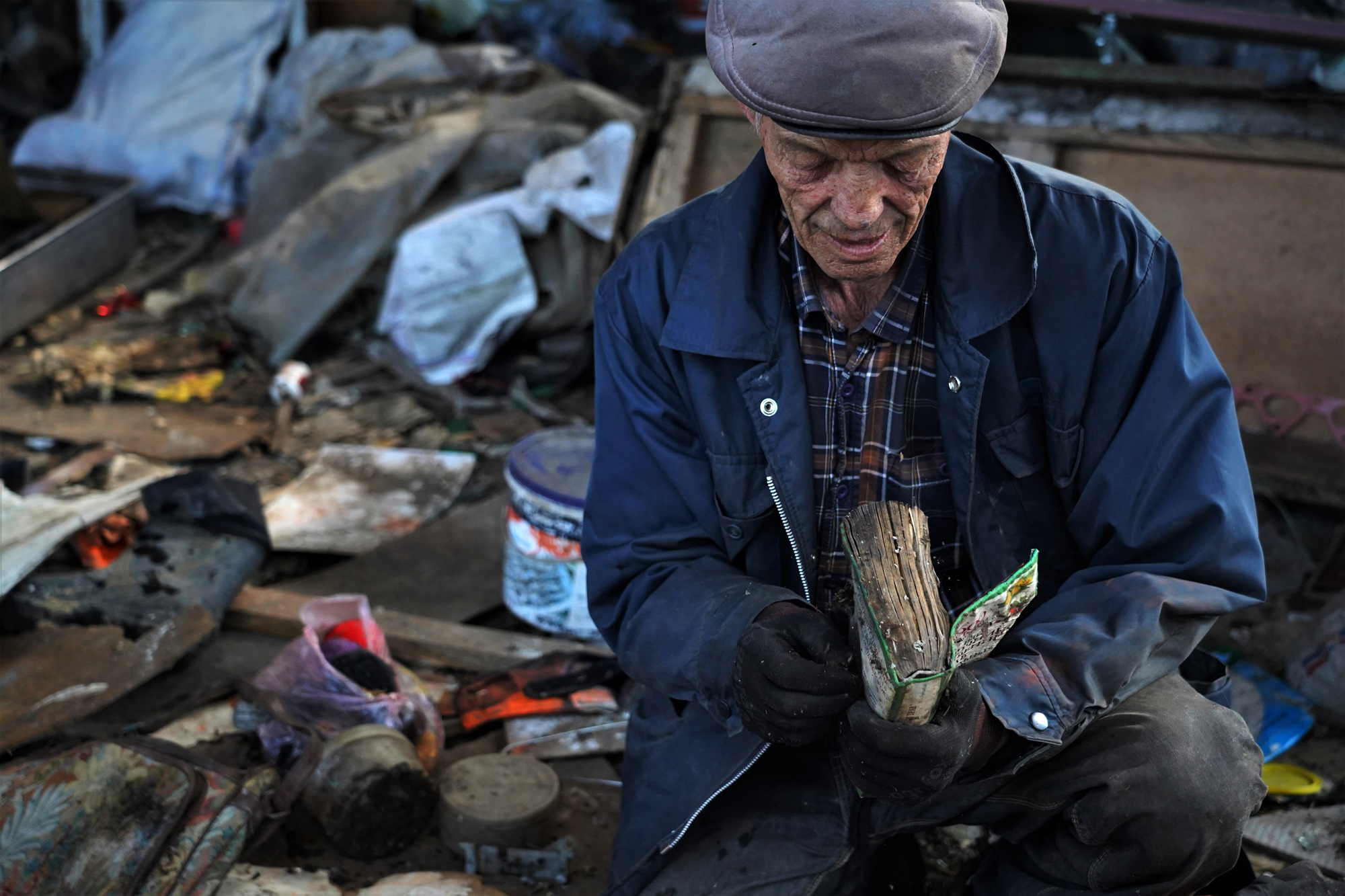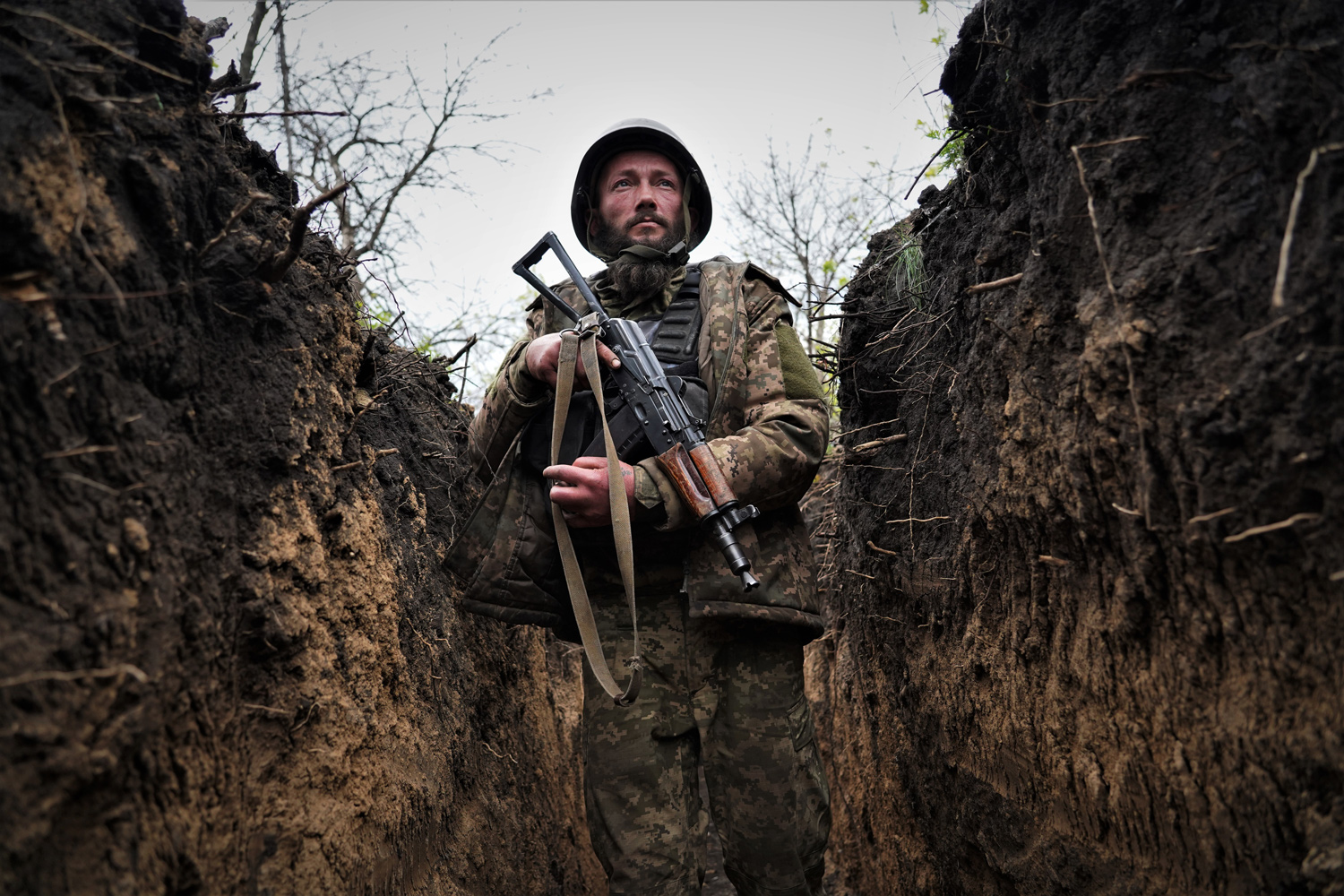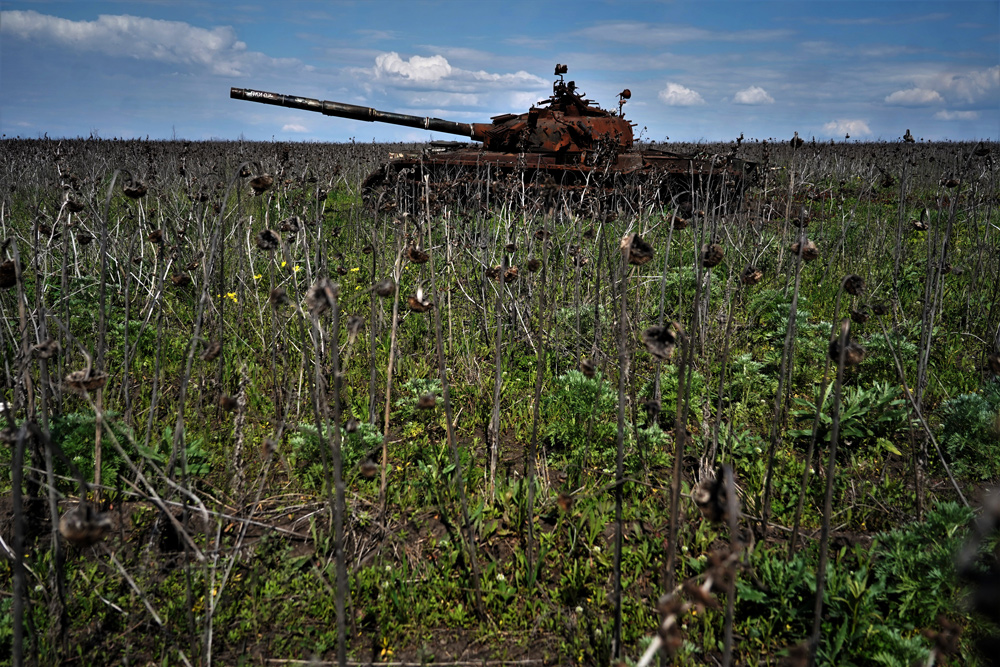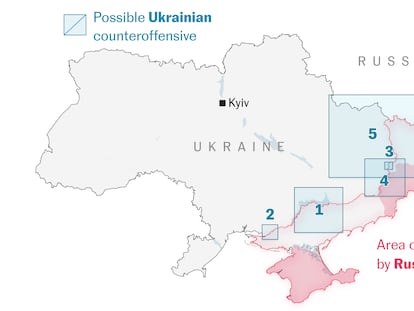Ukraine: A journey to the front that has the world on edge
Special correspondents from EL PAÍS traveled along the 750 miles of front lines in the country, collecting testimonies from civilians and soldiers. The people residing in these embattled areas are hopeful about the ongoing counteroffensive, which could decide their destiny
Day and night, for several months, Natalia Valentinova Sitnik heard explosions and gunshots. Even her cows and calves learned to hide behind the trees when shells began to fall.
Her town — Snigurivka, in southeastern Ukraine — was occupied by the Russians from April to November 2022. It became a warzone. She says that, today, everything is relatively calm, but about a month ago, 10 missiles fell in a single day. Hardly anyone walks in the streets.
Natalia, 66, lives in a two-storey house with a garden full of tulips and daisies. The property overlooks the Ingulets River. It’s an idyllic place, where she milks her cows and makes cream, butter and cheese that she sells to her neighbors. She starts to cry when she thinks about the possibility that the planned Ukrainian counteroffensive will not go well — that the Russians will return, that her city, once again, will be on the front lines of battle. “It’s our hope to end this war and finally move on.”
Serhii and Olga Portianov also need the counteroffensive to be successful, not to stay in their village, but to be able to return to it. The front line is constantly changing; the war has left countless municipalities in ruin. It’s impossible to live in many places, such as their town of Kamianka. Along the bleak road, you can only see destroyed buildings and jumbles of iron.
Serhii and Olga, 72, are determined to return to their home for good, even if they are the only residents of the village, even if they have to sleep in a shed, even if the rubble and fields are riddled with mines. Serhii speaks of the counteroffensive with great hope: “It has to go well. We have to recover our lives, our houses, our towns. Peace.”
Roman is fighting. For 23 years, he lived in Alcalá de Henares, in Spain. But days after the war began, at dawn on February 24, 2022, he decided to return to his country to enlist and defend the freedom and lives of people like Natalia, Olga and Serhii. And here he continues, at the age of 52, now on the strategic Lyman front, between Donetsk and Luhansk. Like him, most of the Ukrainian soldiers are not professionals. Until a year-and-a-half ago, they led the lives of ordinary Europeans: they were bakers, teachers, engineers, drivers. Roman was a construction worker. But now, his day-to-day consists of fighting as an infantryman, in a conflict that has already claimed the lives of some 20,000 Ukrainian soldiers and wounded more than 130,000, according to estimates by U.S. intelligence.
Natalia, Serhii, Olga and Roman are some of the dozens of civilians and soldiers whose testimonies were collected over the course of two weeks by a team of journalists from EL PAÍS. Correspondents from this newspaper have traversed the 750 miles of front lines in the war between Russia and Ukraine, painting a portrait of daily life. They have heard the hopes of Ukrainians, who are counting on the upcoming counteroffensive to liberate the last of the territory conquered by Russian forces.
The government in Kyiv is carefully weighing the best time to launch the response to Russian incursions. From the Kharkiv province in the northeast to Kherson in the south, civilians and soldiers are doing their best to survive, as they count down the days until the country will decide its fate. On May 11, Ukrainian President Volodymyr Zelenskiy told the BBC that the offensive needs more time to commence, so as to avoid a greater number of casualties: “With [what we already have] we can go forward, and, I think, be successful… but we’d lose a lot of people. I think that’s unacceptable. So, we need to wait. We still need a bit more time.”
Ready for combat
Ukraine is reserving its best soldiers for the counteroffensive. Two armored brigades explain that their youngest drivers have been trained abroad in the handling of Leopard tanks and are now ready for combat. In Donetsk, infantrymen confirm that the best-trained troops have left for the front line, to take part in the impending full-scale attack against Russian troops.
The best equipment that Ukraine has will go to the counteroffensive, including armed vehicles such as the Leopards. On the Zaporizhzhia front, Pastor — the code name of a drill sergeant of the 1st Armored Brigade — confirms what other armored units have indicated to this newspaper in past months: that a German Leopard, an American Abrams or a British Challenger are equivalent to two or even three of the most-used tanks by the Ukrainians and the Russians, that is, the Soviet T-64 and T-72.
“To make it clear, it’s as if the Russians have a Tavria [a simple Soviet-era car] and we have a Mercedes Benz. This is the difference between a Leopard and an Abrams when compared to tanks like the T-72. The tanks are already here. Our boys have already been trained to use them.”
The Leopards are like a Mercedes-Benz”Drill sergeant of the 1st Armored Brigade, code named Pastor
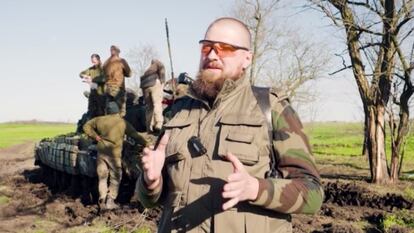
A drill seargent code-named Pastor.
The youngest tankers of the 1st Brigade have been training with the Leopards in Poland. The older soldiers, meanwhile, have been left at the front with the old Soviet tanks. Ukraine doesn’t have as many human resources as Russia. One million men and women are involved in the defense of the state, with about 700,000 serving in the Armed Forces. But the war front is extensive like no other in Europe since World War II, making it difficult to rotate soldiers. Back in April, Ukrainian General Sergei Melnik told EL PAÍS that, ideally, soldiers would be at the front in two-month-long shifts. However, he admitted that, in reality, some fighters haven’t been home for 10 months.
Pastor, for one, hasn’t had a single day off since the invasion began. Despite this — and like many other soldiers interviewed during two weeks of travel — this sergeant displays a temperament that hides any sign of fatigue. Artillery officers in Donetsk, special forces in Kherson, armored units in Zaporizhzhia — and even Melnik, the general in charge of the Kharkiv province — assure EL PAÍS that Ukraine is ready to face the moment of truth.
The most basic military theory indicates that an attacking army needs a superiority of three to one to be able to subdue the defending side. But the challenge facing the Armed Forces of Ukraine is much more difficult. Since last summer, Russia has been steadily erecting 500 miles of fortified defense lines, triple anti-tank barriers, landmines, bunkers and covered positions for artillery and machine guns. General Melnik ventures that, given these conditions, Ukraine needs a four or six-fold advantage.
Foreign Minister Dmitro Kuleba has reiterated that the expectations placed on the counteroffensive are excessive — that the war will not end and that international military support will have to be maintained in the coming months. But the quasi-blank check provided so far to Kyiv by the United States, the United Kingdom and the European Union may indeed come to an end. And, when the time comes to pressure Ukraine into negotiating a way out of the war, the more territory it has regained, the better its position will be.
The vast majority of Ukrainians don’t want to hear anything about negotiating with Russia — between 60% and 70%, according to the latest surveys carried out at the end of 2022. This is what Raisa Stnelcova thinks. She’s an 80-year-old woman who lives in the city of Nikopol, on the banks of the Dnieper River. From Energodar — a city occupied since March of 2022, where the largest nuclear power plant in Europe is located — the enemy bombards Nikopol on a daily basis. A Russian shell recently hit a block of apartments near her.
On the patio of her house, Stnelcova takes advantage of the spring sun to talk with her friend and neighbor, Nadia. She has had a son in the army for nine years — the idea of ending the war by making concessions to Russia is abhorrent to her: “I say no negotiations. The war will end with the absolute expulsion of Russia by Ukraine. So many people have died, so many young people have perished. How can we talk about negotiating?”
Like all Ukrainians, I trust Zaluzhny”Olga Muja, a resident of Marivka, a small village near Nikopol
Olga Muja, together with a neighbor in her orchard, located in front of the Energordar nuclear power plant.
The hope that civilians feel for the upcoming counteroffensive has a first and last name: that of Valeriy Zaluzhny, the commander-in-chief of the Ukrainian Armed Forces. For Olga Muja — who lives opposite the Energodar nuclear power plant, in the district of Marganets — she believes that, if the missiles stop flying over her house and apricot fields every night, it will be because of Zaluzhny’s military genius. “I don’t know if the counterattack will work out, because I’m just an ordinary woman, but like all Ukrainians, I trust Zaluzhny.” You can add another compelling reason to have an almost religious faith in this general: his own son is fighting in the town of Bakhmut.
Millions of Ukrainians have not forgotten that, in 2022, their government ruled out a large-scale invasion, until a few hours before it began. Zaluzhny, on the other hand — as he himself explained to Time magazine — didn’t doubt that Russia would attack the Ukrainian state. And he prepared the army for it, regardless of what the politicians thought, with one priority: to protect the capital of Kyiv. He moved entire regiments from their barracks to secret positions and changed the location of the anti-aircraft defenses, waiting for the Russian offensive to begin. He allowed enemy troops to enter Ukrainian territory from the northern border — through the provinces of Chernihiv, Kyiv and Zhytomyr — to then ambush them and cut off their supplies. A month later, Russia withdrew from its assault on the capital.
Generals like Zaluzhny, along with Oleksandr Sirski — commander of the Ukrainian Ground Forces — or Kiriko Budanov — head of the intelligence services of the Ministry of Defense — are the heroes who have earned the trust of ordinary Ukrainians. The average citizen thinks it’s okay for Zelenskiy to be the face of the country abroad, but it’s these young generals who were the masterminds behind the surprise counteroffensive last September that drove the Russians out of the Kharkiv province. They are the ones who liberated half the province of Kherson in November 2022, despite the enormous political and military collaboration in the region in favor of Russia. And now, it is these generals who must ensure that the country can exist without the Russian threat.
Across Ukraine, there are images that are worth a thousand words. In the center of Huliaipole, on the Zaporizhzhia front, practically no building remains intact. Until last February, fighting was rife in the municipality. The Russian winter offensive in this area, however, was calamitous — the Kremlin’s troops made a hasty retreat. Today, the enemy is less than five miles away. Russian artillery strikes every hour. Inhabitants — a few civilians and many soldiers — avoid walking in the city center. This includes Nina, who left her home and settled in a damp and dark basement-refuge, where she lives alongside six other people in a single room. In the midst of the desolate image of the town, on a still-standing wall, someone has graffitied Zaluzhny’s face, as a symbol of hope for victory.
Ukraine is receiving support from the entire world”Svetlana Tsiba, a municipal functionary in the region of Kupiansk
Svetlana Tsiba — a municipal functionary in the region of Kupiansk — in her kitchen
From the Kupiansk region, on the northern front, municipal functionary Svetlana Tsiba also expresses her admiration for Zaluzhny: “I see that Ukraine supports him, the people support him. From what I read, I have a very positive impression, there is hope.”
Sitting in the kitchen of her house — in a town that was occupied for months by the Russians and liberated in the Kharkiv counteroffensive last summer — Tsiba points out the sometimes competitive relationship between the president and the army chief. “I wouldn’t want Zelenskiy to take over from Zaluzhny. I don’t understand anything about military things, nothing at all. But I want Zaluzhny to lead Ukraine to victory.” What this woman appreciates about her president — like Muja — is that, for the first time, the population is proud of a political leader and that, thanks to his good work abroad, “Ukraine is receiving support from the entire world.”
At the end of 2022, Zaluzhny stated that Ukraine needed 300 new tanks, 700 armored infantry vehicles and 500 NATO howitzers (artillery weapons) to liberate all the territories lost in the war. At the moment, it has about 200 heavy battle tanks (150 of them Leopard tanks) and about 700 infantry vehicles. There are no official figures on the number of cannons provided, although at the beginning of this year, the Center for Strategic and International Studies estimated that the NATO allies had supplied around 450 howitzers.
The Ukrainian Air Force has said that, without American F-16 fighter jets, the success of the counteroffensive is at stake. The White House had initially refused to hand over these aircraft, for fear that Kyiv would use them to attack Russian territory. But on Friday, May 19, President Joe Biden announced his support for an international initiative to begin training Ukrainian pilots for the use of these jets and endorsed allied countries handing them over. Meanwhile, Slovakia and Poland will make up for the shortfall by transferring two squadrons (12 aircraft each) of the less advanced Soviet-era MiG-29 fighters to Kyiv.
“I want to live, but I am no longer afraid of death”
The population that lives along the 750 miles of the front is bracing themselves for battle. Soldiers and civilians are intertwined; they cross paths in the supermarket, they work together, they live together. Although people try to carry on with their lives and jobs whenever possible, the war pervades everything. The children’s math or language classes — taught over Zoom — have gone from the restrictions of the pandemic to online education with bombs in the background. The hospitals now treat the wounded instead of the sick. Women find out through a Telegram message that their partner has just died in the fighting. Sirens don’t stop ringing. The incessant explosions are heard daily by those who cannot or do not want to leave their homes.
In big cities such as Kharkiv or Zaporizhzhia — a little further from the front line — it’s possible to find everyday life. Restaurants and bars still have customers; young people have drinks and have parties. And many have gotten so used to the war that they have stopped being afraid. They all remember perfectly where they were at dawn on February 24, 2022. The feelings of panic, hysteria, uncertainty. “I was celebrating my brother’s wedding outside my city,” recalls Emil Prikhodko, a young man in his twenties from Zaporizhzhia, a city on the Dnieper River, just 25 miles from the front. “We were in Borsipil. At [five in the morning], the missiles woke me up. The war had started. I felt my heart race, a vibration inside me. I heard more than 10 bombs falling nearby.”

Now, more than a year later, one of his best friends has died fighting. A 12-year-old boy who was attending his crossfit classes lost his life, along with his sister, his father and his mother. The grandmother buried them all. But despite all of this, Emil no longer gets on the ground when everything shakes from a missile’s impact.
“I want to live, but I am no longer afraid of death. The war has changed everything. And to live in fear is to let Russia win.” Emil speaks Russian with his family and with his friends. He speaks of peace and brotherhood between peoples, but says, with regret, that the Russians have pushed him to hate them.
The outcome of the counteroffensive is a matter of life and death for Zaporizhzhia, as it would drive away the Russians and allow the city to return to some normality. But for Emil’s parents, it’s already too late: they lost their business — a company that gave tours between Ukraine and Russia — with the Donbas war. His father had to emigrate to another city in Ukraine to find a job. The family is from the east — from a region that once believed in the need for cultural and social ties with Russia.
Emil relates how the tables have progressively changed: a friend stopped listening to Russian music; another stopped speaking Russian, switching to Ukrainian. One of his best friends has not been able to see her parents for more than a year, as they are isolated in a town in a province that is occupied by the invader. Something linked to childhood is especially painful for him: not being able to return to Kyrylivka, a coastal town on the Sea of Azov, where the family used to spend the summers. Russia has not only robbed him of friends and peace: it has robbed him of the beaches of his childhood.
The inhabitants of some towns that are now in ruins — many of them Russian-speaking — confess their astonishment in the face of this savage war, started by those they once considered to be their brothers.”You see, this is the Russkiy Mir,” Olga repeats to herself, as she removes rubble from her destroyed house in the town of Kamianka. Russkiy Mir is a Russian nationalist concept that proclaims cultural unity and shared identity for all Slavic peoples. According to Russian President Vladimir Putin and his spokesmen, Ukraine is part of the Russkiy Mir, whether its inhabitants like it or not.
The fields in Kamianka — like those in neighboring towns — are riddled with anti-tank and anti-personnel mines. There are practically no houses left standing. In Krasnopillia — eight miles from Kamianka — the mayor, Serhii Bagrii, accompanies journalists along paths where destroyed armored vehicles rest. There is also a resident’s vehicle that was blown up by a mine.
In Krasnopillia, a demining team from the State Emergency Service of Ukraine is at work, opening safe routes around power lines. When asked about when they expect to finish clearing the region of mines, a technician answers without hesitation: “40 years.” What seemed like an exaggeration was actually an underestimation, as confirmed by a May 17 interview given on Ukrainian television by Irina Kustova, head of the Ukrainian Deminers Association: the country will not be free of mines for at least 60 years.
This is the reality that awaits the territories that will now be the battlefield of the counteroffensive. Many are regions that Russia occupied with practically no resistance: the defending army was not prepared, while some politicians and civilians collaborated. The drums of war will reach the towns and fields of Zaporizhzhia and eastern Kherson. The capital of this province — liberated last November — is at the front. Only 25% of the population is still there. The commander of another special forces battalion based in the city (who does not wish to be named) cannot hide an air of pessimism. His men have been infiltrating the Russian positions for several months, with many casualties. And then, there are strategic decisions, from the politicians and the generals, that drive him crazy. He feels that, the longer the counteroffensive is delayed, the more exposed his soldiers will be.
For both this high-ranking officer and the inhabitants of Kherson, there is no choice: either the Armed Forces of Ukraine advance, or their city will continue to be bombed. In the worst case scenario, the Russians will return and the place will become the scene of urban fighting — the kind that wiped Mariupol off the map.
“The Russians are barely motivated”
The officers on the front line show a level of conviction that doesn’t appear to be staged. While many anonymously criticize some of the decisions made by political and military leadership, they are all sure that the Ukrainian attack will take them to the coast of the Sea of Azov and the gates of Crimea: that is, to the liberation of the provinces of Zaporizhzhia and Kherson.
Vladislav is the commander of a special forces battalion operating on the Dnieper River, on the southern front. The river — just over a half-a-mile wide — is a gray zone that nobody controls. On one bank are the Ukrainians and on the other, the Russians. Vladislav has a pronounced beard and his face is burned from many hours in the sun — he seems to have stopped caring about his appearance a long time ago. In his vehicle, he has silencers for his rifle and night vision goggles. He has just returned from Bakhmut, where he conducted a covert operation behind enemy lines. He is tired, he rejects many decisions made by his superiors, but he is more than optimistic: he doesn’t doubt victory, because the enemy is poorly-organized.
His men have been infiltrating Russian positions on the eastern side of the Dnieper for months. He is sure that, when they receive the order to start the counteroffensive and storm the river, the Russians will beat a quick retreat. “The Russians are barely motivated. As soon as they come under fire, they take off.” Vladislav has no doubt that his men will be in Crimea this year — the peninsula unilaterally annexed by Russia in 2014, which Putin considers to be an inalienable part of Russian identity.
Kirilo Babii is a lieutenant in the 43rd Artillery Brigade on the Donetsk front. He looks a bit like a warrior monk: calm and sensitive to nature, he wears dreadlocks and a hermit’s beard. In another life, he wanted to be an architect. He shows the journalists a hill in Kramatorsk, from which columns of smoke and missiles can be seen crossing the sky. Babii gives a brief master class on how artillery works, describing its essential role in opening the way for advancing tanks and infantry, as well as its capacity to wear down the morale of the enemy at the moment of assault.
In their brigade, they have howitzers from NATO countries, including American HIMARS — the most decisive rocket launcher in this war — capable of hitting targets that are 50 miles away with a high explosive charge and enormous precision. In the past few weeks, there has also been intense movement of military vehicles on the eastern front, between Kharkiv and Donetsk. EL PAÍS correspondents were able to see two HIMARS shuttle trucks moving in the vicinity of Izium. All mobile artillery batteries are constantly changing their positions to avoid detection. Another sign of the offensive that is coming is the constant circulation of trucks transporting large vehicles: during the day, they are empty, because it’s at night when they move their cargo. More and more armored vehicles are arriving at the front.
Babii’s gaze is penetrating. He stares at the journalists to tell them, with complete seriousness, that this year, they will be able to meet again in Crimea. The peninsula — on the northern coast of the Black Sea — is a special place for Babii: it’s where he was born. It hurts him not to be able to return. It pains him that, since 2014, it has been repopulated with thousands of settlers brought from Russia. He knows that what awaits them there may not be a warm welcome, like what the Allies received when they liberated Paris during World War II. “It’s necessary that the Ukrainians who left Crimea during the annexation return, because you must not only recover the territory. You must get your people back.”
As the days go by and the decisive hour approaches, the anxiety among the population and the military increases. This past April, Oleksii Danilov — secretary of the National Security and Defense Council of Ukraine — revealed that no more than five people had full details of the counteroffensive. Each commander or soldier from their position only sees one piece of the great puzzle: from the sergeant in Bakhmut, who laments that they don’t have enough resources because they are being reserved for the large-scale attack, to members of the special forces, who feel that now is the time to strike. Everyone has doubts and hopes, but they are all united by faith in the legend of General Zaluzhny.
The mayor of Krasnopillia — Serhii Bagrii — sums it up this way: “We have no other choice. It’s our life.”
Credits
Sign up for our weekly newsletter to get more English-language news coverage from EL PAÍS USA Edition
